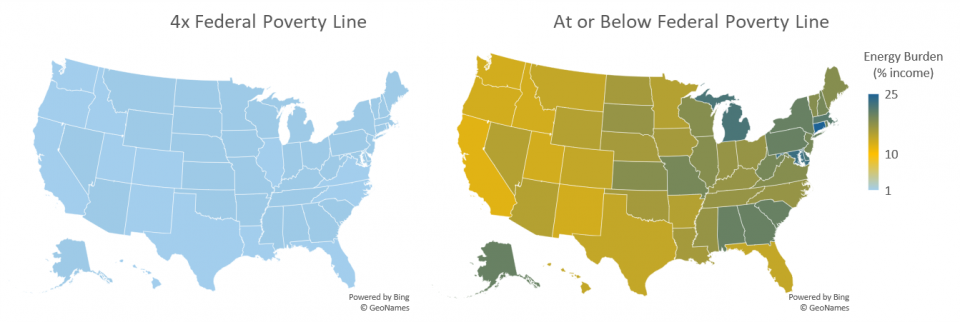This essay sythesizes the ways in which energy vulnerability, energy insecurity, and energy poverty have been used by stakeholders in the United States and elsewhere to describe the condition of unmet energy needs on various scales. This essay should be used to introduce new members of the EVP research team to the terminology that is used by advocacy groups, policy makers, academics, NGO's, and other stakeholders who work with, for, or against the populations that experience energy burdens.
It's important to note that the Energy Insecurity and Energy Poverty sections of this essay are primarily a product research on advocacy and policy publications rather than academic publications, and that the Energy Vulnerability section is a product of academic publications rather than policy and advocacy-related publications, which itself demonstrates how various groups have operationalized these terms. Additionally, this project is ongoing, and should be updated alongside relevant publications.
Morgan Sarao, "Energy Vulnerability, Energy Insecurity, and Energy Poverty," Housing Energy Research Network, Platform for Experimental Collaborative Ethnography, (13 April 2020).

Morgan Sarao recently graduated from Drexel University with a B.A. in political science and a minor in philosophy. Her interests are in equitable urban greening practices rooted in ecofeminist principles and creating more-than-human cities that work to eliminate persistent nature-culture binaries.
The terms energy vulnerability, energy insecurity, and energy poverty are used to describe conditions of unmet energy needs. Energy burdens are experienced by individual households, but are also systematized and interconnected with other equity rooted issues, and are therefore experienced on larger scales by various vulnerable populations, such as the impoverished and the elderly. To some extent, the terms listed have been used interchangeably by policy makers, government officials, and academics to describe this condition on varied scales, which has created dialogue around energy-based hardships that appears to be siloed amongst stakeholders. In order to move forward with a research project on energy-based hardships, it’s critical to first understand the ways in which these terms have been assigned varied meaning by different stakeholders, which will help ensure that the terminology we choose to use is suitable in the context that we’re working in.
Academics in the United Kingdom have recently begun theorizing using the term “energy vulnerability", and have used it as a framework for thinking about unmet energy needs. Bouzarvoski, amongst other scholars, have argued that the terms energy or fuel poverty are used to describe the experience of unmet energy services at a given point in time, and that energy vulnerability can therefore be used to describe the set of sociotechnical variables that lead to the experience of energy/fuel poverty. While energy/fuel poverty is a state within a specific temporal frame that a household, community, or country may come in and out of, energy vulnerability highlights the risk factors of this state as they relate to systemic inequalities that are experienced by different populations. These sociotechnical variables can include lack of adequate technical infrastructure in developing countries and poor energy efficiency and degraded housing stocks in developed countries. While the energy vulnerability framework has been used in the European Union to inform energy policy, energy vulnerability hasn’t been adopted as an academic framework nor has the term been used to develop policy in the United States.
Energy insecurity has been used by government offices and by academics in the United States to describe the conditions of unmet energy needs. The Senate Committee on Energy and Natural Resources describes energy insecurity as the condition “when one cannot afford the energy required to heat or cool their homes or secure other basic needs such as refrigeration”, and academic Diana Hermandez defines energy insecurity as the” inability to adequately meet basic household energy needs”. While some stakeholders in the United States define energy insecurity in relation to the unmet energy needs of households, other sources, such as the American Security Project, the U.S. Department of Energy, and the Strauss Center at the University of Texas have defined energy in[security] as a domestic issue relating to a country’s ability to have reliable access to energy as it needs it at an affordable price. Energy insecurity is thus a term that is used in the United States to talk about energy-related burdens on multiple scales.
Energy poverty appears to be the term that is used most commonly to describe conditions of unmet energy needs, and is defined by the International Energy Agency as “a lack of [household] access to … electricity and clean cooking facilities, where clean cooking facilities are defined as fuels and stoves that do not cause air pollution in the house”. Another definition of energy poverty is “a set of domestic energy circumstances that do not allow for participating in the lifestyles, customs and activities that define membership of society”, which is a definition that is comparable to widely accepted definitions for relative income poverty. Energy poverty is more frequently used to reference macro-level energy hardships, such as the energy conditions that are experienced across communities in developing countries, but is still widely used to describe the condition where an individual or household is experiencing energy hardships in the United States.

Maps showing the percent of household income spent on household energy bills for households with income four times higher than the federal poverty line (left) and households with income below the federal poverty line (right). Energy burdens are exacerbated for those already living in poverty, especially for households in the northeast.

These maps show the cost of annual energy bills for single family homes (left) and multi-unit homes (right) that are below the poverty line. Single family dwellings seemingly spend more on annual energy costs than multi-unit dwellings.

These maps show annual energy bills for owner occupied households (left) and renter occupied households (right) below the poverty line. Interestingly, owner occupied households tend to spend more on annual energy costs than renters. Perhaps landlords have the resources to conduct energy retrofits which in turn reduce the energy costs for renters in poverty, whereas homeowners living below the poverty line may not have the access to capital to make those same investments.